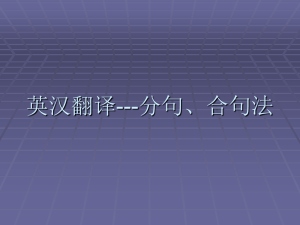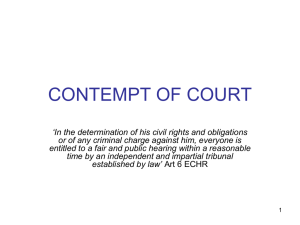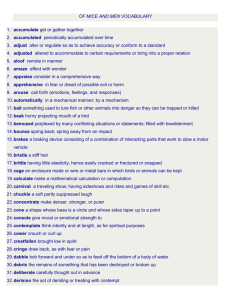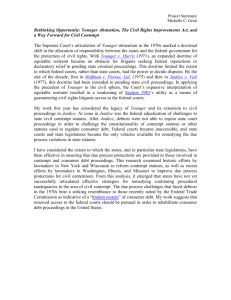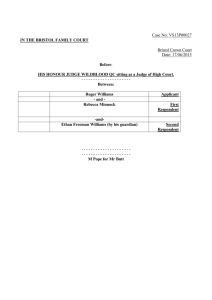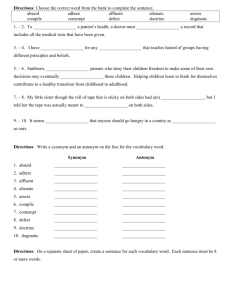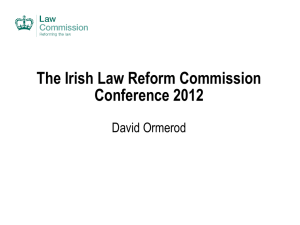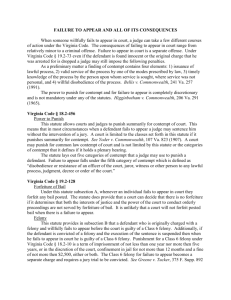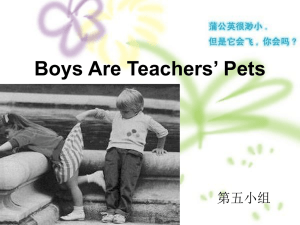Contempt: The Court's Inherent Enforcement Power
advertisement
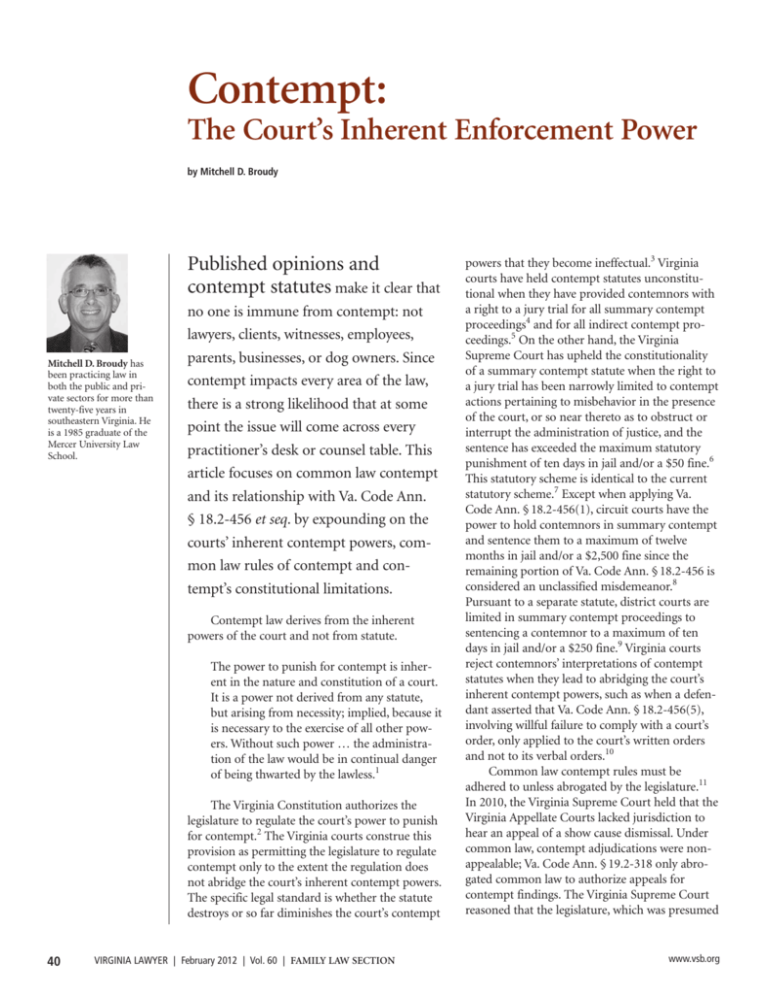
Contempt: The Court’s Inherent Enforcement Power by Mitchell D. Broudy Published opinions and contempt statutes make it clear that Mitchell D. Broudy has been practicing law in both the public and private sectors for more than twenty-five years in southeastern Virginia. He is a 1985 graduate of the Mercer University Law School. no one is immune from contempt: not lawyers, clients, witnesses, employees, parents, businesses, or dog owners. Since contempt impacts every area of the law, there is a strong likelihood that at some point the issue will come across every practitioner’s desk or counsel table. This article focuses on common law contempt and its relationship with Va. Code Ann. § 18.2-456 et seq. by expounding on the courts’ inherent contempt powers, common law rules of contempt and contempt’s constitutional limitations. Contempt law derives from the inherent powers of the court and not from statute. The power to punish for contempt is inherent in the nature and constitution of a court. It is a power not derived from any statute, but arising from necessity; implied, because it is necessary to the exercise of all other powers. Without such power … the administration of the law would be in continual danger of being thwarted by the lawless.1 The Virginia Constitution authorizes the legislature to regulate the court’s power to punish for contempt.2 The Virginia courts construe this provision as permitting the legislature to regulate contempt only to the extent the regulation does not abridge the court’s inherent contempt powers. The specific legal standard is whether the statute destroys or so far diminishes the court’s contempt 40 VIRGINIA LAWYER | February 2012 | Vol. 60 | FAMILY LAW SECTION powers that they become ineffectual.3 Virginia courts have held contempt statutes unconstitutional when they have provided contemnors with a right to a jury trial for all summary contempt proceedings4 and for all indirect contempt proceedings.5 On the other hand, the Virginia Supreme Court has upheld the constitutionality of a summary contempt statute when the right to a jury trial has been narrowly limited to contempt actions pertaining to misbehavior in the presence of the court, or so near thereto as to obstruct or interrupt the administration of justice, and the sentence has exceeded the maximum statutory punishment of ten days in jail and/or a $50 fine.6 This statutory scheme is identical to the current statutory scheme.7 Except when applying Va. Code Ann. § 18.2-456(1), circuit courts have the power to hold contemnors in summary contempt and sentence them to a maximum of twelve months in jail and/or a $2,500 fine since the remaining portion of Va. Code Ann. § 18.2-456 is considered an unclassified misdemeanor.8 Pursuant to a separate statute, district courts are limited in summary contempt proceedings to sentencing a contemnor to a maximum of ten days in jail and/or a $250 fine.9 Virginia courts reject contemnors’ interpretations of contempt statutes when they lead to abridging the court’s inherent contempt powers, such as when a defendant asserted that Va. Code Ann. § 18.2-456(5), involving willful failure to comply with a court’s order, only applied to the court’s written orders and not to its verbal orders.10 Common law contempt rules must be adhered to unless abrogated by the legislature.11 In 2010, the Virginia Supreme Court held that the Virginia Appellate Courts lacked jurisdiction to hear an appeal of a show cause dismissal. Under common law, contempt adjudications were nonappealable; Va. Code Ann. § 19.2-318 only abrogated common law to authorize appeals for contempt findings. The Virginia Supreme Court reasoned that the legislature, which was presumed www.vsb.org CONTEMPT: THE COURT’S INHERENT ENFORCEMENT POWER to be aware of common law, did not intend to authorize appeals of show cause dismissals since the statute neither contained express language nor necessarily implied such authorization.12 The most significant common law rules that impact contempt actions today are the ones distinguishing direct from constructive (indirect) contempt and the ones distinguishing civil from criminal contempt. Direct contempt is “an open insult in the face of the court to the persons of the judges while presiding, or a resistance to its powers in their presence.”13 Constructive contempt is “an act done not in the presence of the court, but at a distance, which tends to belittle, to degrade, or to obstruct, interrupt, prevent, or embarrass the administration of justice (citation omitted).”14 When the contemptuous act is committed in front of the judge, the contemnor may be “instantly apprehended and immediately imprisoned, without trial or issue, and without other proof than its [the court’s] actual knowledge of what occurred.” Two major rationales for summary contempt have evolved over the centuries. First, the court’s self-preservation, a public policy, necessitates the court’s summary contempt authority. Despite summary contempt being “arbitrary in its nature and liable to abuse,” 15 it is absolutely essential to the court’s self-preservation “to maintain order in the courtroom and the integrity of the trial process in the face of an ‘actual obstruction of justice.’” 16 (Citations omitted). Second, no additional evidence is necessary since the court witnessed the contempt and is “competent to proceed … on its own knowledge of the facts.”17 (Citations omitted). For constructive contempt, procedural protections of a plenary hearing are afforded the contemnor. Although Va. Code Ann. § 18.2-456 indicates that the court may summarily proceed on any of the five enumerated categories of contempt, common law requires that for a contemnor to be held in summary contempt, the contemptuous behavior must have occurred in the presence of the court.18 When the contempt is committed in the court’s presence, the judge may proceed summarily utilizing Va. Code Ann. § 18.2-456 or proceed under common law indirect contempt, with a plenary proceeding including formal service of process on the contemnor. If the court proceeds in a plenary manner, the punishment limitations pertaining to summary proceedings as set forth above do not apply.19 Common law retrospectively analyzes whether the contemnor is in civil or criminal contempt. The focus is solely on the nature and www.vsb.org purpose of the court’s punishment. If the punishment, including fine or imprisonment, is determinate and unconditional, then it is criminal (punitive) in nature — i.e., a sixty-day jail sentence; if the punishment is conditional and the contemnor can eradicate the penalty by purging the contempt through compliance with the court order, then the punishment is civil (remedial) in nature — i.e., a sixty-day jail sentence that can be purged by paying off his or her support arrearage (the contemnor “carries the keys of his own prison in his pocket” 20) (citations omitted). The purpose of civil penalties (purge requirements) are either compensatory (to compensate for the plaintiff’s losses) or coercive (to compel a recalcitrant contemnor to comply with an order).21 With that said, one of the tenets of common law contempt is that courts “must exercise the least possible power adequate to the end proposed.” 22 (Citations omitted). Under appropriate circumstances, the courts may wish either to suspend the imposition of the punishment (incarceration or a fine) or suspend the punishment itself in order to coerce compliance. Under either such circumstance, the issue arises as to whether such suspensions are civil or criminal in nature. If the conditional requirement placed on the contemnor is refraining from a prohibited act, then the suspended imposition of punishment or suspended punishment is criminal in nature, and if the conditional requirement placed on the contemnor is performing an affirmative act (a court-ordered act which he refused to do in the past), which complied with purges the contempt, then the suspended imposition of punishment or suspended sentence is civil in nature.23 When criminal contemnors are punished for doing prohibitive acts, unlike civil contemnors, they forfeit the keys to the jail house because criminal contemnors can- Common law retrospectively analyzes whether the contemnor is in civil or criminal contempt. not undo what they have already done. Under these circumstances, the ability of any criminal contemnor to avoid the punishment is “indistinguishable from the ability of any ordinary citizen to avoid a criminal sanction by conforming his behavior to the law.” 24 FAMILY LAW SECTION | Vol. 60 | February 2012 | VIRGINIA LAWYER 41 CONTEMPT: THE COURT’S INHERENT ENFORCEMENT POWER Courts have traditionally held suspended sentences with probationary terms as criminal in nature; however, the U.S. Supreme Court declared under certain circumstances a suspended sentence was civil in nature where the informal probationary terms in a support matter specifically included the repayment of the arrearage during a determinate period of probation and, in the event the arrearage was paid in full sooner, the probation would terminate and the The U.S. Supreme Court has deferred to the states on how to allocate the burdens of proof for civil contempt proceedings. contemnor would no longer be subject to the possible revocation of the suspended sentence.25 In other words, the terms of probation included an affirmative act which if complied with would purge the punishment. Although contempt, an inherent power of the court, with a robust body of common law has very few legislative road blocks, it does collide into one in dealing with constitutional protections, namely ones afforded to criminal defendants. It is reversible error when the judge transforms civil contempt into criminal contempt by providing a determinate, unconditional punishment.26 Constitutional rights inure to criminal defendants that do not inure to civil defendants, including a standard of proof of guilt beyond a reasonable doubt,27 the right against self-incrimination,28 the right to counsel,29 and the right to a jury trial if the contempt is a “serious crime” with incarceration of six months or more.30 While in the civil (common law) context, the petitioners need only prove that the contemnors failed to comply with the court’s order and then the burden shifts to the contemnors to show affirmatively that they did not have the ability to comply, in a criminal (constitutional law) context, the commonwealth must not only prove beyond a reasonable doubt that the contemnors failed to comply with a court’s order but that the failure to comply was willful.31 The U.S. Supreme Court has deferred to the states on how to allocate the burdens of proof for civil contempt proceedings.32 In flushing out the parameters of the affirmative defense of ability to comply, Virginia courts have held that the contemnors’ ability to 42 VIRGINIA LAWYER | February 2012 | Vol. 60 | FAMILY LAW SECTION comply must “be without fault” and that when they have “voluntarily and contumaciously brought on the disability to obey the order,” 33 they could not avail themselves to this defense. Even where the contemnors have been confronted with difficult options (one of those options being complying with the order) and the contemnors have consciously decided on another option, they could not have availed themselves to an inability to comply defense for they should have sought relief through the courts.34 Regarding jail for criminal contempt and the right to a jury, the U.S. Supreme Court has held that the threshold to being entitled to a jury trial is receiving an unconditional, determinate sentence of six months or more of incarceration. The rule does not limit a district court judge’s ability to sentence a contemnor up to twelve months for indirect criminal contempt in a plenary hearing because the defendant has a right to appeal the matter to circuit court, “triggering his right to a jury trial.” 35 A contemnor appealing an adjudication of summary contempt from district court does not receive a trial de novo in the circuit court with attendant Sixth Amendment protections to face his accuser, the judge, in light of Va. Code Ann. § 18.2-459.36 Constitutionally, for civil indirect contempt there is no right to a jury trial — no matter the length of incarceration; although highly unlikely, the judge has the authority to grant a jury trial statutorily through a plea in equity or an issue out of chancery.37 While the district court is limited to its jurisdictional limits of incarceration of one year for indirect contempt, the circuit court can incarcerate the contemnor for an indefinite period until the contemnor purges the contempt, except in support matters where the court is limited to an indeterminate sentence of up to twelve months in jail.38 While sheriffs give criminal contemnors “good time” credit under Va. Code Ann. § 53.1-116 for reducing the contemnors’ incarceration periods, they do not give civil contemnors “good time” credit.39 In conclusion, the body of law surrounding contempt is a complex road map which can be navigated by remembering the three basic tenets that (1) the court’s contempt power is inherent and can be merely regulated by the legislature; (2) common law contempt rules are controlling unless expressly modified by the legislature; and (3) constitutional protections afforded criminal contemnors may impact both criminal and civil contempt proceedings causing reversible error. www.vsb.org CONTEMPT: THE COURT’S INHERENT ENFORCEMENT POWER Endnotes: 1 Carter v. Commonwealth, 2 Va. App. 392, 395, 345 S.E. 2d 5, 7 (1986). 2 Va. Const. Art. IV, § 14 (2011). 3 Yoder v. Commonwealth, 107 Va. 823, 829, 57 S.E. 581, 583 (Va. 1907). 4 Carter v. Commonwealth, 96 Va. 791, 32 S.E. 780 (1899). Burdett v. Commonwealth, 103 Va. 838, 48 S.E. 878 5 (1904). 6 Yoder, 107 Va. at 829, 57 S.E. at 583. 7 Davis v. Commonwealth, 219 Va. 395, 247 S.E.2d 681 (1978); See Greene v. Tucker, 375 F. Supp. 892 (E.D. Va. 1974). 8 1988 Va. AG Op. 7. 9 Va. Code Ann. § 16.1-69.24 (2011). 10 Robertson v. Commonwealth, 181 Va. 520, 25 S.E.2d 352 (1943). 11 Va. Code Ann. § 1-200 (2011). 12 In that Va. Code Ann. § 16.1-69.24 has similar language as Va. Code Ann. § 19.2-318, the issue arises whether a party can appeal a show cause dismissal from juvenile court or general district court to circuit court. 13 Ex parte Terry, 128 U.S. 289, 309 (1888). 14 Burdett, 103 Va. at 843, 48 S.E. at 880. 15 Ex parte Terry, 128 U.S. at 313-314 . 16 Scialdone v. Commonwealth, 279 Va. 422, 443, 689 S.E.2d 716, 727 (2010). 17 Id. at 443, 689 S.E.2d at 727. 18 Id. at 444, 689 S.E.2d at 728. 19 Robinson v. Commonwealth, 41 Va. App. 137, 145, 583 S.E.2d 60, 64 (2003). 20 21 22 23 24 25 26 27 28 29 30 31 32 33 34 35 36 37 38 39 Int’l Union v. Bagwell, 512 U.S. 821, 828 (1994). Powell v. Ward, 15 Va. App. 553, 558-560, 425 S.E.2d 539, 542-544 (1993). Hicks v. Feiock, 485 U.S. 624 (1988). Gompers v. Bucks Stove & Range Co., 221 U.S. 418, 441-443 (1911). Int’l Union, 512 U.S. at 837. Hicks, 485 U.S. at 639-640 (1988). United Steelworkers of America v. Newport News Shipbuilding & Dry Dock Co., 220 Va. 547, 260 S.E.2d 222 (1979); Powell at 560, 425 S.E.2d at 544. Int’l Union, 512 U.S. at 826 . Id., 512 U.S. at 826. Krieger v. Commonwealth, 38 Va. App. 569, 567 S.E.2d 557 (2002); Turner v. Rogers, 564 U.S. __ (2011). Int’l Union , 512 U.S. at 826. Id., 485 U.S. at 637-38. Hicks, 485 U.S. at 641 (fn. 13) (1988). Laing v. Commonwealth, 205 Va. 511, 514-515, 137 S.E.2d 896, 898-899(1964) Epps v. Commonwealth, 47 Va. App. 687, 714-716, 626 S.E.2d 912, 925-926 (2006). United States v. Gordon, 264 Fed. App’x. 274, 277 (4th Cir. 2008) (unpublished); Va. Sup. Ct. R. 3A:13(a) (2011). Gilman v. Commonwealth, 275 Va. 222, 225-226, 657 S.E.2d 474, 476-477 (2008). McGann v. Royer, 66 Va. Cir. 483, 484 (2003). Va. Code Ann. § 20-115 (2011). 2004 Va. AG Op. 16, 6-7. Join the VSB Family Law Section Visit our website at http://www.vsb.org/site/sections/family for information on becoming a member of the section and to find family law seminars, CLEs, public information brochures, Spare the Child video, section newsletters, and links to resources and forms. www.vsb.org FAMILY LAW SECTION | Vol. 60 | February 2012 | VIRGINIA LAWYER 43
